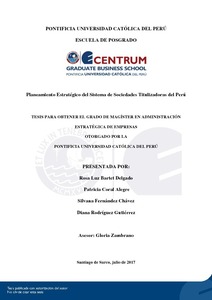| dc.contributor.advisor | Zambrano Aranda, Gloria María Regina | |
| dc.contributor.author | Bartet Delgado, Rosa Luz | es_ES |
| dc.contributor.author | Coral Alegre, Patricia | es_ES |
| dc.contributor.author | Fernández Chávez, Silvana | es_ES |
| dc.contributor.author | Rodríguez Gutiérrez, Diana | es_ES |
| dc.date.accessioned | 2017-08-10T20:09:47Z | |
| dc.date.available | 2017-08-10T20:09:47Z | |
| dc.date.created | 2017 | |
| dc.date.issued | 2017-08-10 | |
| dc.identifier.uri | http://hdl.handle.net/20.500.12404/9193 | |
| dc.description.abstract | La titulización en el Perú inició en 1996, con la promulgación de la Ley del Mercado
de Valores (Decreto Legislativo Nº 861) y su consiguiente Reglamento de los Procesos de
titulización de Activos. Esta iniciativa se implementó como resultado de la experiencia
exitosa en los mercados financieros norteamericano y europeo, y su posterior expansión en el
mercado latinoamericano, en países como: México, Colombia y Chile. Cabe resaltar, que la
titulización de activos tiene como objetivo promover la desintermediación financiera a través
del mercado de valores, a fin de obtener financiamiento al menor costo posible y en forma
directa, reduciendo así la intermediación bancaria.
En la actualidad el sistema de sociedades titulizadoras está creciendo en línea con la
economía peruana, sobre todo en los sectores financiero e inmobiliario, los cuales presentan
oportunidades importantes para el sector de titulización, como consecuencia del déficit de
vivienda en el Perú. Por otro lado, el sistema de sociedades titulizadoras presenta debilidades
importantes como la poca difusión de la titulización como alternativa de financiamiento, una
estructura organizacional débil y la deficiencia y lentitud en el proceso de titulización.
Por lo tanto, el presente plan estratégico tiene como finalidad neutralizar las
debilidades del sistema capitalizando sus fortalezas principales, lo cual le permitirá
aprovechar las oportunidades del mercado. Las estrategias que se plantean son intensivas y
de penetración en el sector inmobiliario y financiero, dotando de liquidez a la banca múltiple
y cajas municipales con el fin de incrementar los créditos hipotecarios en los niveles
socioeconómicos B y C. De esta manera, al 2027 el sistema de sociedades titulizadoras será
reconocido por el sector inmobiliario y financiero como una alternativa de financiamiento
competitiva, promoviendo el bienestar social para el país al incrementar el acceso a la
vivienda. | es_ES |
| dc.description.abstract | Securitization in Peru began in 1996 with the promulgation of the Securities Market
Law (Legislative Decree No. 861) and then it was followed by the Regulation of the Asset
Securitization Processes. This initiative was implemented as a result of the successful
experience in the North American and European financial markets and the consecutive
expansion in the Latin American market in countries such as Mexico, Colombia and Chile. It
should be noted that the main goal of asset securitization is to promote financial
disintermediation through the securities market, in order to obtain financing at the lowest
possible cost and directly way, thus reducing banking intermediation.
At present, the system of securitization companies is growing in line with the Peruvian
economy, especially in the financial and real estate sectors, which present important
opportunities for the securitization sector, as a consequence of the housing deficit in Peru. On
the other hand, the system of securitization companies presents important weaknesses such as
the lack of diffusion of securitization as a financing alternative, a weak organizational structure,
and the lack and slowness of the securitization process.
Therefore, this strategic plan aims to neutralize the weaknesses of the system by
capitalizing on its main strengths, which will allow it to take advantage of market opportunities.
The strategies are intensive and penetration in the real estate and financial sector, providing
liquidity to multiple banks and municipal savings banks in order to increase mortgages in
socioeconomic levels B and C. In this way, by 2027 System of titling companies will be
recognized by the real estate and financial sector as an alternative of competitive financing,
promoting social welfare for the country by increasing access to housing | es_ES |
| dc.language.iso | spa | es_ES |
| dc.publisher | Pontificia Universidad Católica del Perú | es_ES |
| dc.rights | info:eu-repo/semantics/openAccess | es_ES |
| dc.rights.uri | http://creativecommons.org/licenses/by-nc-nd/2.5/pe/ | * |
| dc.subject | Hipotecas | es_ES |
| dc.subject | Crédito | es_ES |
| dc.subject | Planificación estratégica | es_ES |
| dc.title | Planeamiento estratégico del sistema de sociedades titulizadoras del Perú | es_ES |
| dc.type | info:eu-repo/semantics/masterThesis | es_ES |
| thesis.degree.name | Magíster en Administración Estratégica de Empresas | es_ES |
| thesis.degree.level | Maestría | es_ES |
| thesis.degree.grantor | Pontificia Universidad Católica del Perú. CENTRUM | es_ES |
| thesis.degree.discipline | Administración Estratégica de Empresas | es_ES |
| renati.discipline | 413307 | es_ES |
| renati.level | https://purl.org/pe-repo/renati/level#maestro | es_ES |
| renati.type | https://purl.org/pe-repo/renati/type#tesis | es_ES |
| dc.publisher.country | PE | es_ES |
| dc.subject.ocde | https://purl.org/pe-repo/ocde/ford#5.02.04 | es_ES |






